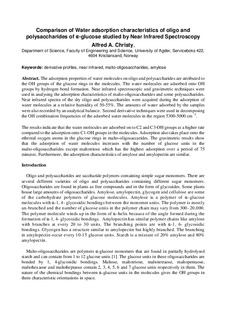Comparison of Water Adsorption Characteristics of Oligo and Polysaccharides of α-glucose STUDIED by Near Infrared Spectroscopy
Journal article, Peer reviewed
Permanent lenke
http://hdl.handle.net/11250/2372801Utgivelsesdato
2014Metadata
Vis full innførselSamlinger
Originalversjon
10.4028/www.scientific.net/AMR.1035.476Sammendrag
The adsorption properties of water molecules on oligo and polysaccharides are attributed to the OH groups of the glucose rings in the molecules. The water molecules are adsorbed onto OH groups by hydrogen bond formation. Near infrared spectroscopic and gravimetric techniques were used in analysing the adsorption characteristics of malto-oligosaccharides and some polysaccharides. Near infrared spectra of the dry oligo and polysaccharides were acquired during the adsorption of water molecules at a relative humidity of 50-55%. The amounts of water adsorbed by the samples were also recorded by an analytical balance. Second derivative techniques were used in decomposing the OH combination frequencies of the adsorbed water molecules in the region 5300-5000 cm -1.The results indicate that the water molecules are adsorbed on to C2 and C3-OH groups at a higher rate compared to the adsorption onto C1-OH groups in the molecules. Adsorption also takes place onto the ethereal oxygen atoms in the glucose rings in malto-oligosaccarides. The gravimetric results show that the adsorption of water molecules increases with the number of glucose units in the malto-oligosaccharides except maltotriose which has the highest adsorption over a period of 75 minutes. Furthermore, the adsorption characteristics of amylose and amylopectin are similar.
Beskrivelse
-
